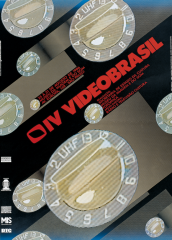- Fotoptica
- Museu da Imagem e do Som (São Paulo)
- Secretaria de Estado da Cultura de São Paulo
By its fourth edition, the Festival was fully integrated into the Brazilian art scene, having become a pivotal space for video screenings. The competitive exhibition attracted the largest number of applicants to that date. Experimental videos and documentary films were the highlights (taking the spotlight away from fiction), with productions that lived up to international trends of the time. Prizing was split into two categories: VHS and U-Matic.
Back at Museu da Imagem e do Som (Museum of Image and Sound), the Festival featured an extensive, never-before-seen parallel programme, bringing in art work from Germany, Canada, France, and England, plus 80 United States productions. The museum was literally wrapped up by artist José Roberto Aguillar, in a performance that payed tribute to Bulgarian artist Christo.
Visual identity and graphic design | Kiko Farkas

Programme
competitive show
Competitive Show | 4th Festival
The 4th edition saw the extinction of genre-based categories (fiction, music video, experimental), the sole division being between the U Matic and VHS formats, for award purposes. The Competitive Show received a large number of submissions: 192 pieces were narrowed down to a 40-strong shortlist.
film and/or video screenings
International Show: Canada
The exhibition, titled Recent Canadian Video, featured artworks from the collection of the Consulate of Canada, created by the artists who represented the country at the 14th International Biennial of São Paulo, in 1977.
International Show: England
The British exhibition, held in partnership with the British Council, featured recent video productions selected by London Video Art, an organization that distributes work by independent artists.
International Show: France
The exhibition featured videos made between 1982 and 1984, divided into three major segments: “Vidéo de Creation”, “Art Vidéo Français” and “La est Mirros Honiplement qui Grirce”.
International Show: Germany
Organized by Munich’s Goethe Intitut, the German video exhibition features a selection of non-commercial productions with political and social overtones.
José Roberto Aguilar Videography (1974-1984)
A screening of videos made by José Roberto Aguilar between 1974 and 1984, selected by Lucila Meirelles and Walter Silveira. The artist made his bet on videographic language before the emergence of independent production companies, at a time when equipment was still hard to come by.
Secretaria de Estado da Cultura Incentive Prize
Screening of winning works of the 1st Video Stimulus Prize, held in 1985 by the State Secretariat for Culture, via the Radio and TV commission.
TV Bixiga
The Festival opens its doors to the works of TV Bixiga and TV Pelourinho, created by residents in the namesake neighbourhoods of São Paulo and Bahia, respectively. The purpose is to circulate and value the life, the history and cultural activities of these areas.
USA Show - Contemporary Video
The exhibition featured 80 videos selected from the Video Data Bank, one of the United States’ premier production companies at the time, with a collection of 2,000-plus titles, which used to host screenings at the most unusual locations, such as Chicago’s drive-in theaters.
Videographics
The exhibition featured graphic computing vignettes created by the companies Art Sistemas, Computer Arts, Computer Graphics, Daniel Messias - Cinema de Animação, Fernando Lebbolo, Neo Comunicações, Palette, Pixxel and Vetor Zero.
exhibition
"Alquimistas da Imagem", curated by Roberto Amado
The program featured works created by three photographers, Milton Montenegro, Carlos Fadon Vicente and Kenji Ota, using computerized images.
performance
"Anti-Christo", José Roberto Aguilar
During the opening of the Festival, the MIS was converted into a mammoth black plastic package, unpacked during Aguilar’s Anti-Christo performance, in a reference to the Bulgarian artist who wraps up landmarks, bridges and beaches.
public programs
Debate: "A Descentralização da Televisão"
Coordinated by Paulo Nasser, the debate focused on the privatization of the means of communication and on mammoth information monopoly empires, as well as the impasses involved in building an open, democratic public opinion.
Debate: "Culpa do Videobrasil"
Debate sponsored by the APTI (Associação Paulista de Teleprodutores Independentes – São Paulo Independent Television Producers Association), the first organization to represent this class in Brazil, and by the Festival’s management, to discuss the interests of independent video producers.
Debate: "Financiamento da Produção Cultural"
Coordinated by Alberto Baumstein, the debate focused on the financing of cultural productions via the Sarney Law, the private initiative’s participation in culture and the commoditization of cultural production.
Debate: "Televisão: Concessão e Legislação"
Coordinated by Gabriel Priolli, the debate focused on the legislation in effect in Brazil, the new technologies and suggestions for a new Brazilian legislation, seeking to discuss a communications policy in the country.
Lecture with Hartmut Horst (Germany)
The German International Exhibition was preceded by the “Video Alternatives” seminar, organized by the Goethe Institut and featuring the German journalist and video artist Hartmut Horst, founder of the Medien Operative Berlin / Mediopolis Berlin Video.